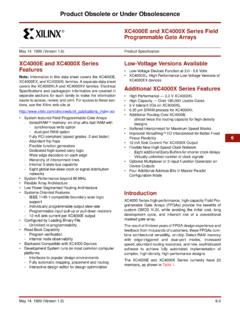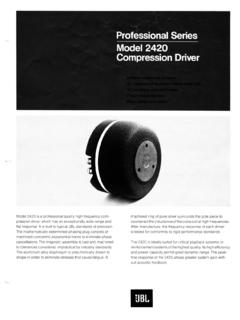Transcription of Obsolete Product(s) - Obsolete Product(s) - st.com
1 August 2011 Doc ID 1461 Rev 31/1818 TDA205032 W hi-fi audio power amplifierFeatures High output power (50 W music power IEC rules) High operating supply voltage (50 V) Single or split supply operations Very low distortion Short-circuit protection (OUT to GND) Thermal shutdownDescriptionThe TDA 2050 is a monolithic integrated circuit in a Pentawatt package, intended for use as an audio class-AB audio amplifier. Thanks to its high power capability the TDA2050 is able to provide up to 35 W true RMS power into a 4 ohm load at THD = 0%, VS = 18 V, f = 1 kHz and up to 32 W into an 8 ohm load at THD = 10%, VS = 22 V, f = 1 kHz.
2 Moreover, the TDA2050 delivers typically 50 W music power into a 4 ohm load over 1 sec at VS = V, f = 1 high power and very low harmonic and crossover distortion (THD = typ, at VS = 22 V, PO = to 15 W, RL= 8 ohm, f = 100 Hz to 15 kHz) make the device most suitable for both hi-fi and high-end TV sets. Figure and application circuitTable summaryOrder codePackageTDA2050 VPentawatt verticalPentawatt Obsolete product (s) - Obsolete Product(s) Device overviewTDA20502/18 Doc ID 1461 Rev 31 Device overviewTable maximum ratingsTable dataFigure connections (top view)Figure diagramSymbolParameterValueUnitVsSupply voltage 25 VViInput voltageVsViDifferential input voltage 15 VIoOutput peak current (internally limited)
3 5 APtotPower dissipation at TCASE = 75 C25 WTstg, TjStorage and junction temperature -40 to 150 CSymbolParameterValueUnitRth j-caseThermal resistance junction-case3 (max) C Obsolete product (s) - Obsolete Product(s) TDA2050 Device overviewDoc ID 1461 Rev 33/18 The values given in the following table refer to the test circuit VS = 18 V, Tamb = 25 C, f = 1 kHz, unless otherwise characteristicsSymbolParameterTest voltage range 25 VIdQuiescent drain currentVs = = 2530555090mAmAIbInput bias currentVs = AVOSI nput offset voltageVs = 22 15mVIOSI nput offset current 200nAPoOutput powerd = , RL = 4 RL = 8 Vs = 22 V, RL = 8 2422281825 WWWd = 10%,RL = 4 RL = 8 Vs = 22 V, RL = 8 352232 WWWM usic power rulesd = 10%.
4 T = 1sRL = 4 ; Vs = V50 WdDistortionPo = to 24W, RL = 4 , f = 1 kHz f = 100 to 10 kHz, Po = to 18 = 22 V, RL = 8 ,f = 1 kHz, Po = to 20 W, f = 100 Hz to 10 kHz;Po = to 15 rate58V/ sGvVoltage gain (open loop)f = 1 kHz80dBGvVoltage gain (closed loop)f = 1 bandwidth (-3dB)Vi = 200 mW, RL = 4 ; 20 to noise voltageB = Curve AB = 22 Hz to 22 kHz4510 V VRiInput resistance (pin 1)500k SVRS upply voltage rejectionRg = 22 k , f = 100 Hz;Vripple = VRMS45dBhEfficiencyPo = 28 W, RL = 4 65%Po = 25 W, RL = 8 ,Vs = 22 V,67%Tsd-jThermal shutdown junction temperature150 C Obsolete product (s) - Obsolete Product(s) Device overviewTDA20504/18 Doc ID 1461 Rev 3 Figure typical application circuitFigure board and component layout of split-supply typical application circuitR3R2R1C2C4C3R4C5C6C1C7+VsRL-VsTDA 2050Vi Obsolete product (s) - Obsolete product (s)
5 TDA2050 Split-supply application suggestionsDoc ID 1461 Rev 35/182 Split-supply application suggestionsThe recommended values of the external components are those shown on the application circuit of Figure 5. Different values can be used. The following table can help the values of external componentsComponentRecommendedvaluePurpo seLarger thanrecommended valueSmaller thanrecommended valueR122 k Input impedanceIncrease of input impedanceDecrease of Input ImpedanceR2680 Feedback resistorDecrease of gain(1)1. The gain must be higher than 24 dBIncrease of gainR322 k Increase of gainDecrease of gain(1) Frequency stabilityDanger of oscillationsC11 FInput decoupling DCHigher low-frequency cutoffC222 FInverting input DC decouplingIncrease of switch ON/OFF noiseHigher low-frequency cutoffC3, C4100 nFSupply voltage bypassDanger of oscillationC5, C6220 FSupply voltage bypassDanger of FFrequency stabilityDanger of oscillation Obsolete product (s) - Obsolete product (s)
6 Split-supply application suggestionsTDA20506/18 Doc ID 1461 Rev Printed circuit boardThe layout shown in Figure 5 should be adopted by the designers. If different layouts are used, the ground points of input 1 and input 2 must be well decoupled from the ground return of the output in which a high current typical application circuitFigure board and component layout of single-supply typical application circuit Obsolete product (s) - Obsolete Product(s) TDA2050 Single-supply application suggestionsDoc ID 1461 Rev 37/183 Single-supply application suggestionsThe recommended values of the external components are those shown in the application circuit of Figure 6.
7 Different values can be used. The following table can help the valuesNote:If the supply voltage is lower than 40 V and the load is 8 ohm (or more), a lower value of C2 can be used ( 22 mF). C7 can be larger than 1000 F only if the supply voltage does not exceed 40 thanrecommended valueSmaller thanrecommended valueR1, R2, R322 k Biasing resistorR4680 Feedback resistorIncrease of gain Decrease of gain(1) 1. The gain must be higher than 24 dBR522 k Decrease of gain(1) Increase of Frequency stabilityDanger of FInput decoupling DCHigher low-frequency cutoffC2100 FSupply voltage rejectionWorse turn-off transientWorse turn-on delayC31000 FSupply voltage bypassDanger of oscillations Worse turn-off transientC422 FInverting input DC decouplingIncrease of switching ON/OFFH igher low-frequency cutoffC5100 nFSupply voltage bypassDanger of oscillations FFrequency stabilityDanger of oscillationsC71000 FOutput DC decouplingHigher low-frequency cutoff
8 Obsolete product (s) - Obsolete Product(s) Typical characteristics (split-supply test circuit unless otherwise specified)TDA20508/18 Doc ID 1461 Rev 34 Typical characteristics (split-supply test circuit unless otherwise specified) Figure power vs. supply voltageFigure vs. output powerFigure 10. Output power vs. supply voltageFigure 11. Distortion vs. output power Obsolete product (s) - Obsolete Product(s) TDA2050 Typical characteristics (split-supply test circuit unless otherwise specified)Doc ID 1461 Rev 39/18 Figure 12.
9 Distortion vs. frequencyFigure 13. Distortion vs. frequencyFigure 14. Quiescent current vs. supply voltageFigure 15. Supply voltage rejection vs. frequency Obsolete product (s) - Obsolete Product(s) Typical characteristics (split-supply test circuit unless otherwise specified)TDA205010/18 Doc ID 1461 Rev 3 Figure 16. Supply voltage rejection vs. frequency (single-supply) for different values of C2 (Figure 6)Figure 17. Supply voltage rejection vs. frequency (single-supply) for different values of C2 (Figure 6)Figure 18.
10 Total power dissipation and efficiency vs. output powerFigure 19. Total power dissipation and efficiency vs. output power Obsolete product (s) - Obsolete Product(s) TDA2050 Short-circuit protectionDoc ID 1461 Rev 311/185 Short-circuit protectionThe TDA2050 has an original circuit which limits the current of the output transistors. The maximum output current is a function of the collector emitter voltage, hence the output transistors work within their safe operating area. This function can therefore be considered as being peak power limiting rather than simple current limiting.
















